
Fishing in Cornwall
Encyclopedia
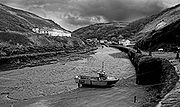
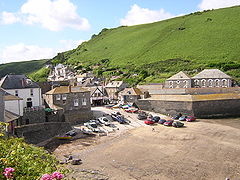
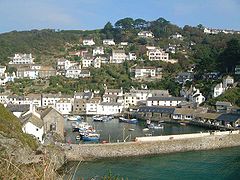
Cornwall
Cornwall is a unitary authority and ceremonial county of England, within the United Kingdom. It is bordered to the north and west by the Celtic Sea, to the south by the English Channel, and to the east by the county of Devon, over the River Tamar. Cornwall has a population of , and covers an area of...
from around 1750 to around 1880, after which it went into an almost terminal decline. During the 20th century the varieties of fish taken became much more diverse and crustaceans such as crab and lobster are now significant. Much of the catch is exported to France due to the higher prices obtainable there. Though fishing has been significantly damaged by overfishing, (the Southwest Handline Fishermen's Association has started to revive the fishing industry).
However, as of 2007, stocks are improving (cf. River Cottage
River Cottage
River Cottage is a former weekend and holiday home that was originally a game-keeper's lodge in the grounds of Slape Manor, Netherbury, Dorset. From 1998 it was used by Hugh Fearnley-Whittingstall as a setting for three television series: Escape to River Cottage, Return to River Cottage and River...
: Gone Fishing 22/11/08).
The industry has featured in numerous works of art, particularly by Stanhope Forbes
Stanhope Forbes
Stanhope Alexander Forbes R.A., , was an artist and member of the influential Newlyn school of painters...
and other Newlyn School
Newlyn School
The Newlyn School is a term used to describe an art colony of artists based in or near to Newlyn, a fishing village adjacent to Penzance, Cornwall, from the 1880s until the early 20th century. The establishment of the Newlyn School was reminiscent of the Barbizon School in France, where artists...
artists.
Early history
The beginnings of a significant fishery in Cornwall may be traced to the reign of King John and by the time of the Tudors had become of national importance. It was much regulated under the rule of Queen Elizabeth I. In 1582 nearly two thousand mariners are recorded for Cornwall and somewhat more for Devon. In 1602 Richard Carew describes the fisheries of Cornwall and Devon as much more important than those of eastern England. Two methods were in use at the time: seining and drifting. In the early years of the 17th century the fishermen of Cornwall and Devon were also heavily involved in the Newfoundland fisheries. In the decade 1747-1756 the total number of pilchards dispatched from the four principal Cornish ports of Falmouth, Fowey, Penzance and St Ives averaged 30,000 hogsheads annually (making a total of 900 million fish). Much greater catches were achieved in 1790 and 1796. The majority of the pilchard catch was exported to Italy. Before the mid 18th century the season generally ran from July till November or December but during the 19th century usually from August to October.In 1847 the exports of pilchards from Cornwall amounted to 40,883 hogsheads or 122 million fish while the greatest number ever taken in one seine was 5,600 hogsheads at St Ives in 1868.
Huers (cliff top lookouts) helped locate shoals of fish. The huer would shout 'Hevva!, Hevva!' to alert the boats to the location of the pilchard shoals. Cornish tradition states that Hevva cake was baked by the huers on their return to their homes, the cake being ready by the time the crews returned to land.
North coast
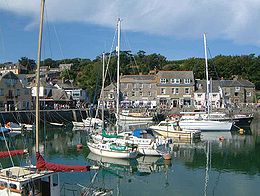
Up to the early 20th century, Newquay
Newquay
Newquay is a town, civil parish, seaside resort and fishing port in Cornwall, England. It is situated on the North Atlantic coast of Cornwall approximately west of Bodmin and north of Truro....
was a small fishing port famous for pilchards and there is a "Huer's Hut" above the harbour from which a lookout would cry "Hevva!" to call out the fishing fleet when pilchard shoals were spotted. The town's present insignia
Insignia
Insignia or insigne pl -nia or -nias : a symbol or token of personal power, status or office, or of an official body of government or jurisdiction...
is two pilchards. The real pilchards have long gone, but a small number of boats still catch the local edible crab
Edible crab
Cancer pagurus, commonly known as the edible crab or brown crab, is a species of crab found in the North Sea, North Atlantic Ocean and perhaps in the Mediterranean Sea. It is a robust crab of a reddish-brown colour, having an oval carapace with a characteristic "pie crust" edge and black tips to...
s and lobsters
European lobster
Homarus gammarus, known as the European lobster or common lobster, is a species of clawed lobster from the eastern Atlantic Ocean, Mediterranean Sea and parts of the Black Sea. It is closely related to the American lobster, H. americanus. It may grow to a length of and a mass of , and bears a...
.
On the north west coast the harbours are generally smaller and Port Isaac, Port Quin
Port Quin
Port Quin is a small cove and hamlet between Port Isaac and Polzeath on the Atlantic coast in north Cornwall, England, UK.The hamlet and the coastline is mainly owned by the National Trust for Places of Historic Interest or Natural Beauty; the Trust rents out several of the stone cottages as...
(now deserted), Bossiney and Boscastle
Boscastle
Boscastle is a village and fishing port on the north coast of Cornwall, England, in the civil parish of Forrabury and Minster. It is situated 14 miles south of Bude and 5 miles north-east of Tintagel....
have relied on fishing, though there is a larger harbour at Bude
Bude
Bude is a small seaside resort town in North Cornwall, England, at the mouth of the River Neet . It lies just south of Flexbury, north of Widemouth Bay and west of Stratton and is located along the A3073 road off the A39. Bude is twinned with Ergué-Gabéric in Brittany, France...
. In the eighteenth century there was a small unprotected tidal harbour at Bude, but it was difficult whenever the sea was up. The Bude Canal Company built a canal and improved the harbour. Nowadays around twenty small boats use the tidal moorings of the original harbour during the summer months. Most are sport fishermen, but there is also some small-scale, semi-commercial, fishing for crab and lobster.
South coast, western
The principal industry in NewlynNewlyn
Newlyn is a town and fishing port in southwest Cornwall, England, United Kingdom.Newlyn forms a conurbation with the neighbouring town of Penzance and is part of Penzance civil parish...
is fishing, and the town relies upon its harbour. Newlyn's history has been strongly linked to its role as a major fishing port. The natural protection afforded by the Gwavas
Gwavas
Gwavas is a residential council estate on the southern outskirts of the town of Newlyn in west Cornwall, United Kingdom. It is situated immediately west of Gwavas Road and takes its name from nearby Gwavas Farm....
Lake (an area of seawater in Mounts Bay) led to many local fishermen using this area as a preferred landing site.. Newlyn harbour is first recorded in 1435 by the Bishop of Exeter
Bishop of Exeter
The Bishop of Exeter is the Ordinary of the Church of England Diocese of Exeter in the Province of Canterbury. The incumbent usually signs his name as Exon or incorporates this in his signature....
; later large scale improvements to the harbour led to Newlyn becoming the predominant fishing port in Mounts Bay.
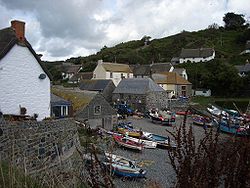
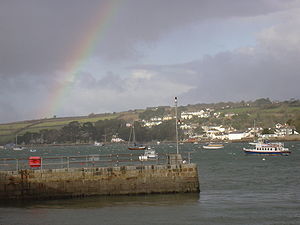
Cadgwith
Cadgwith is a village and fishing port in Cornwall, United Kingdom. It is situated on the Lizard Peninsula between The Lizard and Coverack.-History:...
was established in medieval times as a collection of fishing cellars in a sheltered south-east facing coastal valley with a shingle
Shingle beach
A shingle beach is a beach which is armoured with pebbles or small- to medium-sized cobbles. Typically, the stone composition may grade from characteristic sizes ranging from two to 200 mm diameter....
cove to subsidise local farmers' livelihoods by fishing Cadgwith was originally called Caswydh or Porthcaswydh (thought to be derived from the Cornish
Cornish language
Cornish is a Brythonic Celtic language and a recognised minority language of the United Kingdom. Along with Welsh and Breton, it is directly descended from the ancient British language spoken throughout much of Britain before the English language came to dominate...
word for 'a thicket'; probably because the valley was densely wooded). From the 16th century, the village became inhabited, with fishing as the main occupation. Subsequently buildings were established as homes, lofts, capstan houses, and cellars constructed of local stone or cob
Cob (building)
Cob or cobb or clom is a building material consisting of clay, sand, straw, water, and earth, similar to adobe. Cob is fireproof, resistant to seismic activity, and inexpensive...
walls, and thatched or slated roofs; which were built along the beach and up the sides of the valley leading to Cadgwith's characteristic Cornish fishing village appearance. Cadgwith owes its existence to the fishing industry. Pilchard fishing occurred until the 1950s using large seine boats and seine nets, which was a system used to enclose the large shoals of pilchards, and coordinated by the use of lookouts, known as huers (from the Cornish 'Hevva, Hevva!' ('Here they are!)), positioned on the cove's two headlands. In 1904, a record 1,798,000 pilchards were landed over four days. Due to overfishing and climate changes pilchards are no longer found in large enough numbers to sustain pilchard fishing in Cadgwith, instead crab
Crab
True crabs are decapod crustaceans of the infraorder Brachyura, which typically have a very short projecting "tail" , or where the reduced abdomen is entirely hidden under the thorax...
and lobster
Lobster
Clawed lobsters comprise a family of large marine crustaceans. Highly prized as seafood, lobsters are economically important, and are often one of the most profitable commodities in coastal areas they populate.Though several groups of crustaceans are known as lobsters, the clawed lobsters are most...
fishing occurs. Brown edible crabs
Edible crab
Cancer pagurus, commonly known as the edible crab or brown crab, is a species of crab found in the North Sea, North Atlantic Ocean and perhaps in the Mediterranean Sea. It is a robust crab of a reddish-brown colour, having an oval carapace with a characteristic "pie crust" edge and black tips to...
, spider crab
Maja squinado
Maja squinado is a species of migratory crab found in the north-east Atlantic and the Mediterranean Sea.-Diet:M...
s, lobsters, shark
Shark
Sharks are a type of fish with a full cartilaginous skeleton and a highly streamlined body. The earliest known sharks date from more than 420 million years ago....
s, monkfish
Monkfish
Monkfish is the English name of a number of types of fish in the northwest Atlantic, most notably the species of the anglerfish genus Lophius and the angelshark genus Squatina...
, and conger eel
Conger
Conger is a genus of marine congrid eels. It includes some of the largest types of eels, ranging up to 3 m in length, in the case of the European conger...
are regularly landed with most being sold abroad through fish merchants but some being sold locally by the fishmonger, the café, public house, and seafood snack shop.
In the Helford River
Helford River
The Helford River is a ria located in Cornwall, England, UK, and not a true river. It is fed by a number of small streams into its numerous creeks...
oyster fishing has been carried on though pollution has disrupted this. At Port Navas is the Duchy Oyster Farm
Duchy of Cornwall
The Duchy of Cornwall is one of two royal duchies in England, the other being the Duchy of Lancaster. The eldest son of the reigning British monarch inherits the duchy and title of Duke of Cornwall at the time of his birth, or of his parent's succession to the throne. If the monarch has no son, the...
and the oyster fishery in the River is expanding. In the 19th and 20th century, Flushing
Flushing, Cornwall
Flushing is a coastal village in Cornwall, United Kingdom. It is situated three miles south of Penryn and eleven miles south-east of Truro. It faces Falmouth across the Penryn river, an arm of the Carrick Roads...
's economy mainly relied upon fishing, farming and Falmouth Docks
Falmouth Docks
Falmouth Docks are the docks of the town of Falmouth in Cornwall, England, UK.The docks are served by the Falmouth Docks railway station. Policing is by the Falmouth Docks Police.-Further reading:...
; there are now only a few commercial fishing vessels based in the village.
The current harbour at Mevagissey
Mevagissey
Mevagissey is a village, fishing port and civil parish in Cornwall, United Kingdom. The village is situated approximately five miles south of St Austell....
was built on the site of a medieval quay. The first Act of Parliament allowing the new port to be built was passed in 1774. The inner harbour, consisting of the current East and West Quays was constructed from this time. An outer harbour was added in 1888, but seriously damaged in a blizzard in 1891. The outer walls were rebuilt by 1897. The harbour was given charitable trust
Charitable trust
A charitable trust is an irrevocable trust established for charitable purposes, and is a more specific term than "charitable organization".-United States:...
status in 1988. There are currently 63 registered fishing vessels in the harbour worked by 69 fishermen. The harbour also offers tourist fishing trips and there is a regular summer passenger ferry to Fowey
Fowey
Fowey is a small town, civil parish and cargo port at the mouth of the River Fowey in south Cornwall, United Kingdom. According to the 2001 census it had a population of 2,273.-Early history:...
.
South coast, eastern
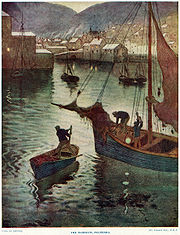
Fowey
Fowey is a small town, civil parish and cargo port at the mouth of the River Fowey in south Cornwall, United Kingdom. According to the 2001 census it had a population of 2,273.-Early history:...
has thrived as a port
Harbor
A harbor or harbour , or haven, is a place where ships, boats, and barges can seek shelter from stormy weather, or else are stored for future use. Harbors can be natural or artificial...
for hundreds of years, initially as a trading and naval town, then as the centre for china clay exports. Today Fowey is busy with trawlers and yacht
Yacht
A yacht is a recreational boat or ship. The term originated from the Dutch Jacht meaning "hunt". It was originally defined as a light fast sailing vessel used by the Dutch navy to pursue pirates and other transgressors around and into the shallow waters of the Low Countries...
s.
Fishing
Fishing
Fishing is the activity of trying to catch wild fish. Fish are normally caught in the wild. Techniques for catching fish include hand gathering, spearing, netting, angling and trapping....
has always been a principal occupation for the people of Polperro
Polperro
Polperro is a village and fishing harbour on the south-east Cornwall coast in South West England, UK, within the civil parish of Lansallos. Situated on the River Pol, 4 miles west of the neighbouring town of Looe and west of the major city and naval port of Plymouth, it is well-known for...
. For centuries the village was a pilchard
Sardine
Sardines, or pilchards, are several types of small, oily fish related to herrings, family Clupeidae. Sardines are named after the Mediterranean island of Sardinia, around which they were once abundant....
fishing and processing port. The fish were drawn to the south Cornwall coast to feed in late summer and brought rich pickings for local fishermen. Once ashore, the fish were salted and pressed and the oil was collected as a by-product and used for heating and lighting. Polperro pilchards were exported to many parts of Europe. Shoals of the fish diminished in the 20th century and pilchard fishing died out in Polperro in the 1960s, but today the port still has around 12 commercial vessels fishing for flat fish, scallops, crabs, monkfish, ray, pollock, bass and cod. The little fishing port of Polperro, 5 miles west of Looe
Looe
Looe is a small coastal town, fishing port and civil parish in the former Caradon district of south-east Cornwall, England, with a population of 5,280 . Looe is divided in two by the River Looe, East Looe and West Looe being connected by a bridge...
, had a fleet of small sailing fishing boats known as Polperro Gaffer
Polperro Gaffer
The Polperro Gaffer is a type of fishing vessel used in Cornwall. The Great Gale of 1891 destroyed the fishing fleets of many of the smaller Cornish villages...
s. Their principal catch was the pilchard but this was a late summer catch and the rest of the year they set long lines, and seine nets. Most were built in Looe, around 26' with a deep 6' draft, a gaff rig on a pole mast stepped on the keel and they dried out on legs in Polperro's drying harbour. Within the village is the Polperro Heritage Museum of Fishing and Smuggling, situated on the harbourside in an old fish processing
Fish processing
The term fish processing refers to the processes associated with fish and fish products between the time fish are caught or harvested, and the time the final product is delivered to the customer...
warehouse, which amongst other things, houses interesting photographs of the village's history. Jonathan Couch
Jonathan Couch
Jonathan Couch was a British naturalist, the only child of Richard and Philippa Couch, of a family long resident at Polperro, a small fishing village between Looe and Fowey, on the south coast of Cornwall.-Biography:...
, the village doctor for many years, was also a notable ichthyologist and trained in succession a large number of fishermen to aid him in his pursuits. His observations made at and near Polperro during his lifetime and since his death have not been equalled in value at any British station. He was in correspondence with many of the foremost naturalists, and especially rendered aid to Thomas Bewick
Thomas Bewick
Thomas Bewick was an English wood engraver and ornithologist.- Early life and apprenticeship :Bewick was born at Cherryburn House in the village of Mickley, in the parish of Ovingham, Northumberland, England, near Newcastle upon Tyne on 12 August 1753...
and to William Yarrell
William Yarrell
William Yarrell was an English bookseller and naturalist.Yarrell is best known as the author of The History of British Fishes and The History of British Birds . The latter went into several editions and was the standard reference work for a generation of British ornithologists...
.
At Looe an early wooden bridge
Bridge
A bridge is a structure built to span physical obstacles such as a body of water, valley, or road, for the purpose of providing passage over the obstacle...
over the Looe river was in place by 1411 which burned down and was replaced by the first stone bridge, completed in 1436 and featuring a chapel dedicated to St Anne
Saint Anne
Saint Hanna of David's house and line, was the mother of the Virgin Mary and grandmother of Jesus Christ according to Christian and Islamic tradition. English Anne is derived from Greek rendering of her Hebrew name Hannah...
in the middle (the current bridge, a seven-arched Victorian
Victorian era
The Victorian era of British history was the period of Queen Victoria's reign from 20 June 1837 until her death on 22 January 1901. It was a long period of peace, prosperity, refined sensibilities and national self-confidence...
bridge, was opened in 1853). By this time Looe had become a major port
Port
A port is a location on a coast or shore containing one or more harbors where ships can dock and transfer people or cargo to or from land....
, one of Cornwall's largest, exporting local tin
Tin
Tin is a chemical element with the symbol Sn and atomic number 50. It is a main group metal in group 14 of the periodic table. Tin shows chemical similarity to both neighboring group 14 elements, germanium and lead and has two possible oxidation states, +2 and the slightly more stable +4...
, arsenic
Arsenic
Arsenic is a chemical element with the symbol As, atomic number 33 and relative atomic mass 74.92. Arsenic occurs in many minerals, usually in conjunction with sulfur and metals, and also as a pure elemental crystal. It was first documented by Albertus Magnus in 1250.Arsenic is a metalloid...
and granite
Granite
Granite is a common and widely occurring type of intrusive, felsic, igneous rock. Granite usually has a medium- to coarse-grained texture. Occasionally some individual crystals are larger than the groundmass, in which case the texture is known as porphyritic. A granitic rock with a porphyritic...
, as well as hosting thriving fishing
Fishing
Fishing is the activity of trying to catch wild fish. Fish are normally caught in the wild. Techniques for catching fish include hand gathering, spearing, netting, angling and trapping....
and boatbuilding
Boat building
Boat building, one of the oldest branches of engineering, is concerned with constructing the hulls of boats and, for sailboats, the masts, spars and rigging.-Parts:* Bow - the front and generally sharp end of the hull...
industries. The town provided some 20 ships for the siege of Calais
Calais
Calais is a town in Northern France in the department of Pas-de-Calais, of which it is a sub-prefecture. Although Calais is by far the largest city in Pas-de-Calais, the department's capital is its third-largest city of Arras....
in 1347. Looe remains a fishing town, and several fish dealers operate from the docks of East Looe. With its fleet of small fishing boats returning their catches to port daily, Looe has a reputation for producing excellent fresh fish. The town is also a centre for shark
Shark
Sharks are a type of fish with a full cartilaginous skeleton and a highly streamlined body. The earliest known sharks date from more than 420 million years ago....
fishing
Big-game fishing
Big-game fishing, often referred to as offshore sportfishing, offshore gamefishing, or blue-water fishing is a form of recreational fishing, targeting large fish renowned for their sporting qualities, such as tuna and marlin.-History:...
, and is the home of the Shark Angling Club of Great Britain.
Customs and events
There is a tradition of holding celebrations associated with fishing, such as the Falmouth Oyster Festival and Newlyn Fish Festival.In fishing communities a dance or "troil
Troyl
Troyl is a colloquial Cornish word meaning a barn-dance or céilidh, a social evening of dance, music and song.. - Etymology :Edward Lluyd knew the Cornish verb troillia - to twist, twirl, whirl, spin round. Edward Veale of Pentire, Newquay used the noun troil in the 1880s to describe a Cornish...
... always terminated the pilchard season. This was a feast for those connected with the cellars, each cellar having its own troil. After the feast, which was given in the loft, games and dancing followed. These were kept up until the small hours of the morning, the music being provided by a fiddler." In 1870 Bottrell considered music integral to harvest home, feast days, even visits to the mill. He mentions 3-hand reels, jigs and ballads sung for dancing. Gorseth Kernow
Gorseth Kernow
Gorseth Kernow is a non-political Cornish organisation, which exists to maintain the national Celtic spirit of Cornwall in the United Kingdom.-History:...
piper Merv Davey’s grandfather, Edward Veale, remembered seeing the step dance, Lattapuch, in the Unity Fish Cellars, Newquay in the 1880s. These reports are borne out by dance collection.
Drama and verse
- Graffiti outside the South Crofty workings:
Cornish lads are fishermen and Cornish lads are miners too.
But when the fish and tin are gone, what are the Cornish boys to do?
- Many of the plays and other works of Nick DarkeNick DarkeNick Darke born Nicholas Temperley Watson Darke was best known as playwright but was also a writer, poet, lobster fisherman, environmentalist, beachcomber, politician, broadcaster, film-maker and chairman of St Eval Parish Council.-Life and writings:Nick Darke was born at St Eval, near Padstow in...
, who himself fished for lobsters, are concerned with fishing in Cornwall.
Food and drink
A traditional Cornish pilchard dish is stargazy pieStargazy pie
Stargazy pie is a Cornish dish made of baked pilchards, along with eggs and potatoes, covered with a pastry crust. Although there are a few variations with different fish being used, the unique feature of stargazy pie is fish heads protruding through the crust, so that they appear to be gazing...
or starry gazy pie
Stargazy pie
Stargazy pie is a Cornish dish made of baked pilchards, along with eggs and potatoes, covered with a pastry crust. Although there are a few variations with different fish being used, the unique feature of stargazy pie is fish heads protruding through the crust, so that they appear to be gazing...
.
Cornish Coaster (3.6% abv) is an ale brewed by Sharp's Brewery at Rock. The coaster, a type of fishing vessel, was used extensively by Cornish fishermen in the last century. Cornish Coaster pays tribute to all those down the centuries who have bravely plied their trade around Cornwall's rugged coastline. Coaster is made from an all malt grist, English hops and a classic open fermentation. Coaster is available in cask only.
Measurements
Cornish warp – 4 fish; Cornish burn – 21 fish; Cornish hundred – 132 fish; Cornish mease – 505 herring; Cornish cran – 800 herring; Cornish long hundred – 8 times 120+5 fish; Cornish last – 132,000 fish; Cornish ounceOunce
The ounce is a unit of mass with several definitions, the most commonly used of which are equal to approximately 28 grams. The ounce is used in a number of different systems, including various systems of mass that form part of the imperial and United States customary systems...
– 16th part (of either a seine of fish or property)
Further reading
- Noall, Cyril (1972) Cornish Seines and Seiners: a history of the pilchard fishing industry. Truro: D. Bradford Barton ISBN 0851530907
- Noall, Cyril (1970) The Story of Cornwall's Ports and Harbours. Truro: Tormark Press
- Todd, A. C. & Laws, Peter (1972) The Industrial Archaeology of Cornwall. Newton Abbot: David & Charles (contains much information on the history of the harbours)

